Solar eclipse of September 3, 2081
A total solar eclipse will occur on Wednesday, September 3, 2081. A solar eclipse occurs when the Moon passes between Earth and the Sun, thereby totally or partly obscuring the image of the Sun for a viewer on Earth. A total solar eclipse occurs when the Moon's apparent diameter is larger than the Sun's, blocking all direct sunlight, turning day into darkness. Totality occurs in a narrow path across Earth's surface, with the partial solar eclipse visible over a surrounding region thousands of kilometres wide. The path of totality will begin at the Atlantic Ocean, off European mainland at 07:26:49 UTC and will end at Indonesian island of Java at 10:43:03 UTC.[1]
| Solar eclipse of September 3, 2081 | |
|---|---|
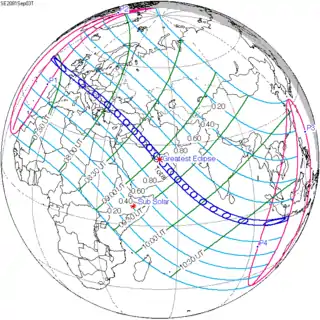 Map | |
| Type of eclipse | |
| Nature | Total |
| Gamma | 0.3378 |
| Magnitude | 1.072 |
| Maximum eclipse | |
| Duration | 333 sec (5 m 33 s) |
| Coordinates | 24.6°N 53.6°E |
| Max. width of band | 247 km (153 mi) |
| Times (UTC) | |
| Greatest eclipse | 9:07:31 |
| References | |
| Saros | 136 (41 of 71) |
| Catalog # (SE5000) | 9690 |
Countries and territories experiencing totality
Major cities
Related eclipses
Solar eclipses 2080–2083
This eclipse is a member of a semester series. An eclipse in a semester series of solar eclipses repeats approximately every 177 days and 4 hours (a semester) at alternating nodes of the Moon's orbit.[2]
| 121 | March 21, 2080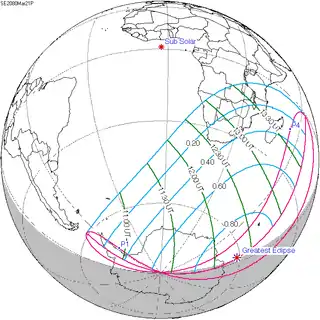 Partial |
126 | September 13, 2080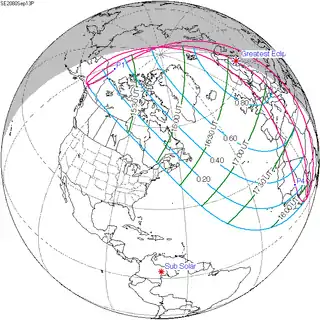 Partial |
| 131 | March 10, 2081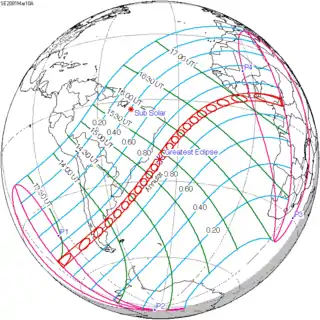 Annular |
136 | September 3, 2081 Total |
| 141 | February 27, 2082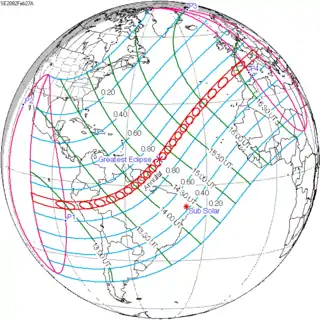 Annular |
146 | August 24, 2082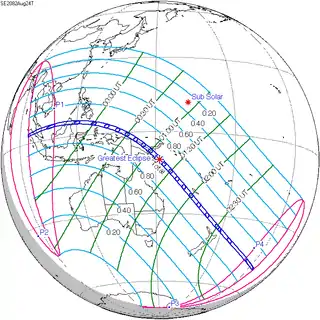 Total |
| 151 | February 16, 2083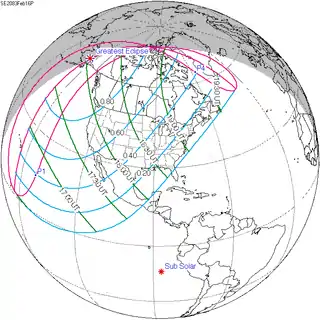 Partial |
156 | August 13, 2083 Partial |
Saros 136
Solar Saros 136, repeating every 18 years, 11 days, contains 71 events. The series started with partial solar eclipse on June 14, 1360, and reached a first annular eclipse on September 8, 1504. It was a hybrid event from November 22, 1612, through January 17, 1703, and total eclipses from January 27, 1721, through May 13, 2496. The series ends at member 71 as a partial eclipse on July 30, 2622, with the entire series lasting 1262 years. The longest eclipse occurred on June 20, 1955, with a maximum duration of totality at 7 minutes, 7.74 seconds. All eclipses in this series occurs at the Moon's descending node.[3]
| Series members 29–43 occur between 1865 and 2117 | ||
|---|---|---|
| 29 | 30 | 31 |
 Apr 25, 1865 |
 May 6, 1883 |
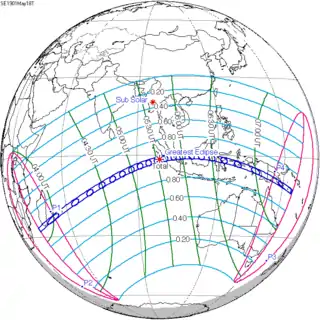 May 18, 1901 |
| 32 | 33 | 34 |
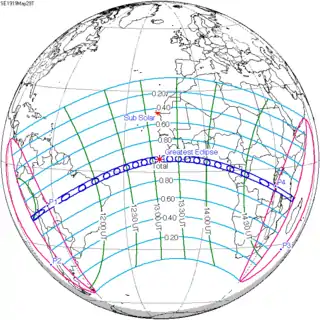 May 29, 1919 |
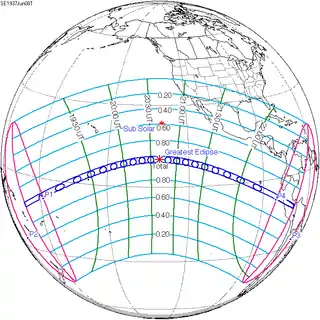 Jun 8, 1937 |
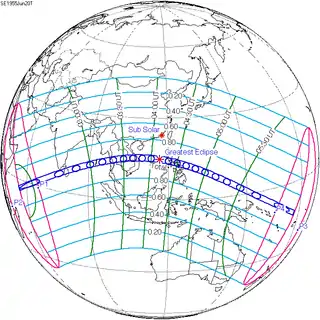 Jun 20, 1955 |
| 35 | 36 | 37 |
 Jun 30, 1973 |
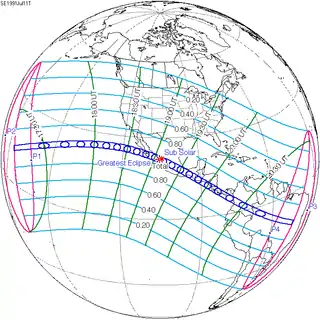 Jul 11, 1991 |
 Jul 22, 2009 |
| 38 | 39 | 40 |
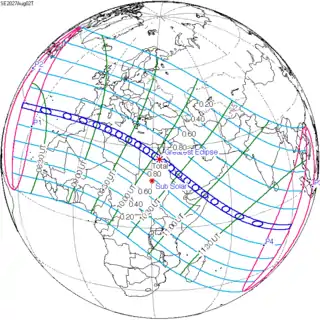 Aug 2, 2027 |
 Aug 12, 2045 |
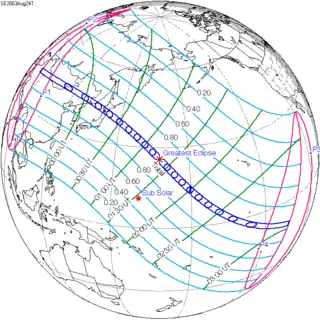 Aug 24, 2063 |
| 41 | 42 | 43 |
 Sep 3, 2081 |
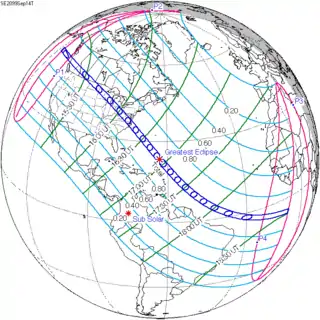 Sep 14, 2099 |
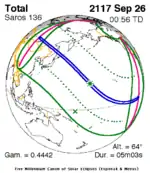 Sep 26, 2117 |
Inex series
This eclipse is a part of the long period inex cycle, repeating at alternating nodes, every 358 synodic months (≈ 10,571.95 days, or 29 years minus 20 days). Their appearance and longitude are irregular due to a lack of synchronization with the anomalistic month (period of perigee). However, groupings of 3 inex cycles (≈ 87 years minus 2 months) comes close (≈ 1,151.02 anomalistic months), so eclipses are similar in these groupings.
| Inex series members between 1901 and 2100: | ||
|---|---|---|
 January 3, 1908 (Saros 130) |
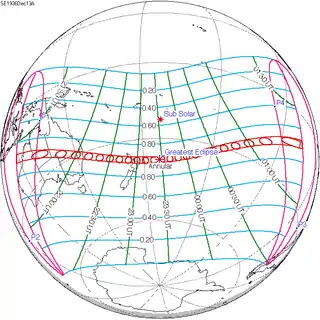 December 13, 1936 (Saros 131) |
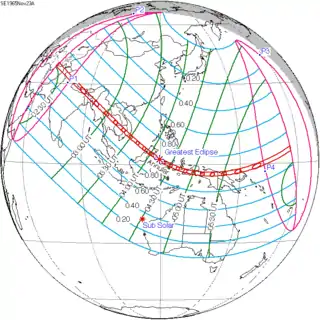 November 23, 1965 (Saros 132) |
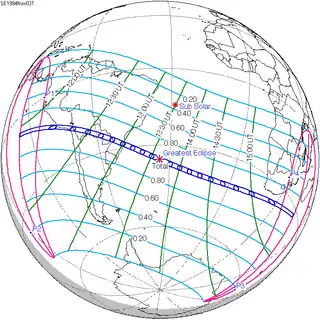 November 3, 1994 (Saros 133) |
 October 14, 2023 (Saros 134) |
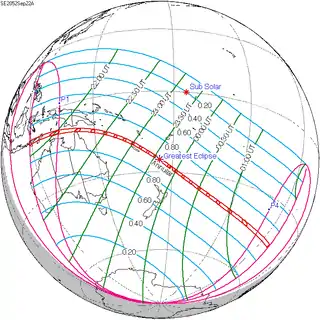 September 22, 2052 (Saros 135) |
 September 3, 2081 (Saros 136) |
||
Notes
- "3 September 2081 Total Solar Eclipse". Timeanddate.com. Retrieved 21 June 2020.
- van Gent, R.H. "Solar- and Lunar-Eclipse Predictions from Antiquity to the Present". A Catalogue of Eclipse Cycles. Utrecht University. Retrieved 6 October 2018.
- SEsaros136 at NASA.gov
References
- Earth visibility chart and eclipse statistics Eclipse Predictions by Fred Espenak, NASA/GSFC
.jpg.webp)

